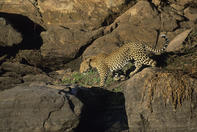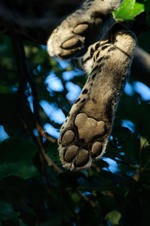Patterns
Leopards have intricate patterning all over their bodies. This pattern is unique to each animal. On the majority of the body, black spots are arranged together to form rosettes.

The back and flanks of the body are a golden colour and the underside almost pure white. In combination, these disruptive markings and colours provide the leopard with highly effective camouflage.
The patterning breaks up the shape of the body and allows the leopard to almost melt invisibly into any habitat. This is critical to facilitate hunting and to remain elusive from its own enemies.
Black leopards or panthers are in fact simple genetic variants of the normal spotted leopard. This black colouring is known as a melanistic form as it is caused by an excess of black pigment called melanin.
Panthera Pardus

Size Male: 70 - 80 cm tall Female: 60 - 70 cm tall
Weight Male: 60 - 90 kg Female: 30 - 60 kg
Habitat Wide tolerance – extremely adaptable but needs good cover to hunt and hide. Territories usually include rocky outcrops and densely wooded drainage lines.
Gestation 100 days
No. of young 2 or 3
Food Wide variety from mice, reptiles and fish to large antelope and small carnivores, mainly medium-sized antelope like impala, readily scavenges.
Predators Cubs killed by lions and spotted hyena
By Megan Emmett